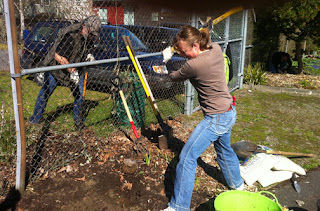Harvest 2012
In spring 2012, we created a new crop in a narrow strip of soil
alongside the basketball court on the property of my neighborhood public garden, Bradner Gardens. With some attention to soil improvements and
consistent watering, we ended up with visual enjoyment of tall green stalks with leaves and eventually mini sunflower-yellow flowers at the tips, and an abundance of sweet tubers to eat. These chokes grow well
in the Northwest and offer up some tasty options for harvesters. They are
delicious additions to soups, roasted vegetable medleys, stir-frys, salads, pasta and
pilaf dishes, root vegetable gratins and Latkes. Besides all this, there are
significant health benefits involved. This tuber has a respectable history as a food source for the
Pilgrims and crop that helped feed Europe during the potato famine. Native to North America, Champlain took them to France in 1605 and reportedly they were
preferred by the French to the potato.
Wiki link providing more history
Harvest 2012
In spring 2012, we created a new crop in a narrow strip of soil
alongside the basketball court on the property of my neighborhood public garden, Bradner Gardens. With some attention to soil improvements and
consistent watering, we ended up with visual enjoyment of tall green stalks with leaves and eventually mini sunflower-yellow flowers at the tips, and an abundance of sweet tubers to eat. These chokes grow well
in the Northwest and offer up some tasty options for harvesters. They are
delicious additions to soups, roasted vegetable medleys, stir-frys, salads, pasta and
pilaf dishes, root vegetable gratins and Latkes. Besides all this, there are
significant health benefits involved. This tuber has a respectable history as a food source for the
Pilgrims and crop that helped feed Europe during the potato famine. Native to North America, Champlain took them to France in 1605 and reportedly they were
preferred by the French to the potato.
Wiki link providing more history
 |
| Community gardeners packaging for the food bank and volunteers |
 |
| Mini sun-choke-flowers at the tippy top reaching skyward. |
 |
| fall color just before harvest |








